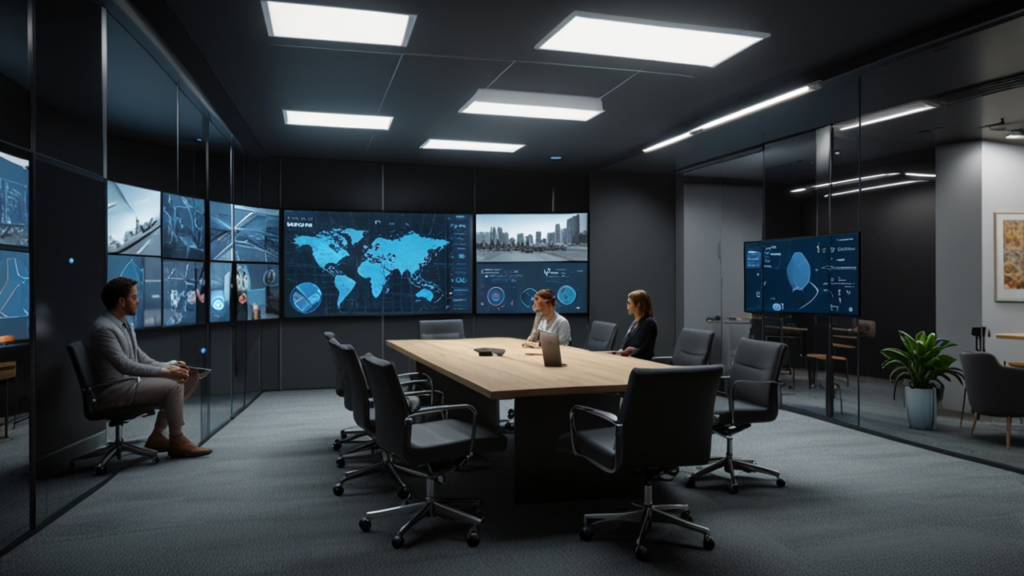Metaverse Workplace: 6 Powerful Advantages
The world of work is transforming rapidly as innovative digital environments begin to shape how we connect and collaborate. This change is driven by breakthroughs in immersive technology and new ways of interacting that make remote work engaging and effective. In this evolving landscape, organizations are reconsidering traditional office setups to embrace a model that champions flexibility and global access.
Today’s professionals enjoy dynamic platforms that allow them to interact in virtual spaces with a sense of physical presence. As these environments develop, businesses of all sizes are experimenting with solutions that blend technology with creativity for enhanced productivity. This transformation has wide-reaching implications that extend beyond the physical limitations of conventional workplaces.
The journey has been influenced by decades of experimentation and innovation, from early online communities to sophisticated simulations. As you continue reading, consider how your own workplace might benefit from these advancements and the opportunities they present.
Table of Contents
- Introduction to Metaverse Workplace
- Evolution and History of Metaverse Workplace
- How Virtual Office Enhances Metaverse Workplace
- Digital Collaboration Systems and Their Applications
- Real-World Case Studies of Metaverse Workplace
- Immersive Productivity in Modern Metaverse Workplace Solutions
- Future Trends: Work Evolution and Beyond
Introduction to Metaverse Workplace
Core Concepts and Definitions
The idea of interconnected digital work environments has fundamentally shifted how companies prioritize employee engagement and operational efficiency. In simple terms, this system creates a three-dimensional, persistent space where avatars represent real people. Such a platform enables a level of interaction that traditional video conferences and chat services cannot match.
Historically, early digital experiences paved the way for this new mode of virtual presence. Pioneering virtual environments led to the concept that work was no longer confined to a physical office space. For more details on evolving tech trends, consult this detailed study on metaverse insights.
When you consider the possibilities, ask yourself: How could a highly interactive digital space redefine employee engagement and connectivity in your organization?
Key Benefits for Modern Organizations
The advantages of adopting these digital environments are numerous. They provide a new form of presence that makes remote teammates feel as if they are physically together. This leads to better engagement and cooperation even when individuals work from scattered locations.
Many organizations have noted a surge in productivity after integrating immersive platforms into their workflows. These digital spaces break geographical barriers and create global teams that collaborate in real time. For instance, platforms like those introduced by Meta and Microsoft have shown measurable improvements in employee satisfaction and efficiency.
Reflect on your current work environment—could enhanced interpersonal interactions boost your team’s creativity?
Also note the partnership with Blockchain initiatives in this space, which further enriches the technology’s foundation.
Evolution and History of Metaverse Workplace
From Early Virtual Worlds to Modern Platforms
The evolution of these immersive digital environments has been long in the making. Early platforms such as Second Life, which emerged in 2003, offered users a shared virtual space to socialize, conduct business, and interact in ways that went far beyond simple messaging systems.
Companies like IBM and Coca-Cola pioneered these digital arenas to experiment with novel methods for both customer engagement and internal collaboration. In addition, when Facebook rebranded as Meta in 2021 and invested over $10 billion in immersive technologies, the mainstream adoption of such environments accelerated significantly. For historical context, refer to this timeline of metaverse development.
Thinking back over the decades, how might your organization have evolved if you had access to such transformative tools from the outset?
Pivotal Moments and Technological Breakthroughs
Several technological milestones have defined the shift toward an immersive digital work environment. A key moment was the development of synchronized virtual platforms like Microsoft Mesh, which promised to merge physical presence with digital interaction. Through ongoing research and academic studies, we now recognize that the metaverse workplace is not just a concept, but a reality that enhances spatial collaboration using avatars.
The successful integration of virtual reality (VR) and augmented reality (AR) has also been crucial. These technologies help create immersive training programs, secure digital transactions, and improved workflow automation. For statistical insights, check out the market size analysis.
Does this progression inspire you to ponder how similar breakthroughs could streamline your workflow?
This section also highlights the influence of Digital Living perspectives in molding this evolution.
How Virtual Office Enhances Metaverse Workplace
Enhanced Interaction and Spatial Presence
Virtual office solutions provide a real feeling of co-location by leveraging avatars and persistent spaces. These environments create a sense of “being there” that is hard to replicate with standard video conferencing tools. Users can interact around digital whiteboards, have spontaneous conversations, and even take virtual coffee breaks together.
This enhanced spatial presence not only boosts collaboration but also helps mitigate feelings of isolation among remote workers. Numerous case studies have demonstrated that the adoption of immersive environments leads to higher engagement and satisfaction. For example, Meta and Microsoft have reported significant improvements in team dynamics after adopting metaverse platforms.
When reflecting on your team’s dynamics, have you considered how a virtual office could foster closer, more personal interactions?
An example of incorporating Cutting-Edge Technologies is seen in systems that support real-time adjustment of virtual spaces to adapt to team needs.
Cost Efficiency and Global Talent Access
The digital approach offers significant cost savings by reducing the reliance on traditional office infrastructure and travel expenses. For many organizations, the return on investment is evident when comparing the costs of physical spaces versus digital collaborative environments. Companies that have integrated these platforms find that the savings can be reinvested into innovation and other growth strategies.
Furthermore, these digital environments expand the talent pool beyond local boundaries, enabling global collaboration. This global reach is particularly beneficial in today’s competitive market where expertise is spread across continents. For more insight into economic advantages, see the industry and companies report.
Imagine the possibilities if travel costs and office fees were no longer barriers—how would your recruiting strategy change?
This discussion integrates ideas from Innovative Solutions that many forward-thinking companies are embracing.
Digital Collaboration Systems and Their Applications
Technologies Driving Collaboration
At the heart of immersive environments are technologies that facilitate deep, meaningful collaboration. Virtual reality (VR) and augmented reality (AR) devices are crucial in creating engaging, spatial settings for meetings and training sessions. With future shipments expected to top 105 million devices, these tools enable real-time interaction in scalable environments.
Digital avatars further enhance communication by providing a face and personality to every participant. Such avatars can be customized to represent individuals accurately, fostering a more natural transition from physical to digital interactions. Check out this insight on immersive technology for further reading.
As you engage with these tools, what features do you think could be most impactful in your day-to-day operations?
This section is enriched with insights from Innovative Solutions to drive forward-thinking digital strategies.
Security, Blockchain, and Regulatory Factors
Another important aspect of collaborative digital environments involves ensuring secure transactions and data protection. Blockchain technology has become an integral component, offering robust security measures and enabling unique digital assets to thrive in these virtual spaces. For those concerned about data privacy and authenticity, blockchain offers a reliable foundation.
Persistent digital environments present new challenges, however, such as how to manage ongoing data privacy and employee monitoring. Regulatory measures are still evolving to catch up with these rapid technological advancements. For a detailed look at regulatory challenges, see this science and tech update.
Are you ready to consider how emerging security protocols could shape your organization’s digital strategy?
Fundamental principles from Digital Transformation are evident in these practices.
Real-World Case Studies of Metaverse Workplace
Success Stories from the Americas and Europe
Many leading companies in the United States and Europe have already seen tangible benefits from integrating immersive environments into their workflows. For instance, Meta’s Horizon Workrooms has led to improved collaboration and a 54% increase in perceived engagement among remote teams. Similarly, Accenture onboarded 150,000 new hires through a virtual campus, thereby enhancing training and knowledge retention.
The experience of Siemens in Germany further demonstrates how digital twins and VR-based training programs can reduce travel costs and accelerate product development. These examples have paved the way for widespread adoption of digital work approaches. Have you experienced a work environment that transformed your team’s dynamics?
Below is a comparison table that summarizes key case studies:
Comprehensive Comparison of Case Studies
| Example | Innovation | Impact | Region |
|---|---|---|---|
| Meta Horizon Workrooms | Virtual meetings | +54% engagement | USA |
| Microsoft Mesh | 3D collaboration | Enhanced project management | USA |
| Siemens VR Training | Digital twins | Reduced costs | Germany |
| Accenture Virtual Campus | Onboarding innovation | Improved retention | UK |
| NTT Docomo Pilot | Virtual offices | Bridged communication gaps | Japan |
These examples from diverse regions illustrate how immersive digital environments are being adopted globally. What lesson from these case studies resonates with your experience?
This case study discussion is enriched by insights from partners in Web3 & Crypto circles.
Case Studies from Asia and Australia
In Asia, innovations are spearheading transformative changes in digital work. For example, NTT Docomo in Japan has implemented virtual offices that utilize advanced spatial audio and real-time language translation to bridge cultural gaps. Likewise, SK Telecom in South Korea developed a platform known as “ifland” that is now widely adopted for business meetings and networking.
In Australia, the Commonwealth Bank has explored virtual collaboration to reinforce security and compliance in remote work environments. These examples highlight how different regions are adapting novel technologies to meet local needs while contributing to a global trend.
Considering your own region’s unique challenges, how might similar innovations impact your everyday work experiences?
These real-world instances reinforce the value of integrating advanced digital practices championed by Digital Living.
Immersive Productivity in Modern Metaverse Workplace Solutions
Tools and Platforms Enhancing Productivity
Modern digital environments deploy an array of innovative tools designed to maximize team productivity. Features such as immersive digital whiteboards, avatar personalization, and real-time data visualization provide a multi-layered approach to collaboration. These elements combine to simulate physical presence, thereby enabling teams to brainstorm and innovate without the limitations of a physical office.
Platforms introduce interactive features that encourage spontaneous interactions, making every meeting a potential hub of creativity. Reports suggest that organizations incorporating these immersive tools have seen improvements in project turnaround times and overall employee satisfaction. For further insights, refer to this Statista analysis.
Have you considered how modern tools might streamline your team’s workflow and spark innovative ideas?
Automation, AI Integration, and Future Developments
Automation and AI-powered assistants have become integral to these virtual work settings. They assist with scheduling meetings, retrieving vital information, and even managing analytics to optimize team performance. This seamless integration of artificial intelligence eliminates repetitive tasks, allowing employees to focus on strategic work.
Looking forward, the trend indicates an increasing reliance on smart algorithms to adapt virtual environments in real time, improved chatbots for internal support, and AI-driven productivity boosters. A recent projection highlights that by 2027, the majority of employers plan to maintain a strong digital presence. This is supported by findings on how AI innovations are reshaping work practices. How do you envision AI and automation transforming your daily tasks?
These transformative practices also echo the vision of Cutting-Edge Technologies that are redefining efficiency in modern organizations.
Future Trends: Work Evolution and Beyond
Predictions and Emerging Innovations
Looking ahead, the future of digital workrooms promises an era of mainstream adoption and global talent connectivity. Predictions indicate that by 2027, over 80% of companies will integrate persistent digital environments into their workflows. This evolution is set to revolutionize how work is envisioned and executed by blending physical and virtual interactions seamlessly.
Innovative integrations such as blockchain-based security mechanisms, real-time remote machine control, and enhanced data visualization are paving the way for new forms of collaboration. Financial investments in these technologies are booming, with companies in the US and UK expected to allocate millions toward immersive tools. For additional predictions, check this in-depth industry report.
As you imagine the future of work, what innovative tools and practices would you champion in your organization?
Societal Impact and Regulatory Challenges
Even with rapid technological progress, the journey toward fully integrated digital work environments is not without its hurdles. Persistent digital platforms pose new challenges in maintaining data privacy and establishing international regulatory standards. Concerns regarding surveillance and employee tracking are prompting policymakers to craft measures to protect human rights in the virtual domain.
Despite these challenges, the potential impact on job creation and global recruitment is immense. As companies look to employ talent from every corner of the world, ethical implementation and stringent security protocols become indispensable. Experts suggest that regional adaptations of labor laws and digital identity norms will evolve, ensuring a balanced approach. Have you thought about the societal changes that might arise from these emerging frameworks?
This future landscape is also intertwined with insights from Digital Transformation theories that explain how regulatory and cultural adaptation can drive innovation.
Innovative Outlook: Metaverse Workplace Insights
This dynamic preview invites you to explore a world of inventive digital experiences that redefine professional engagement. Imagine an environment where everyday tasks transform into interactive ventures, sparking incredible new ways for people to connect and create value together. In this refreshing scenario, you’ll discover a vibrant setting where creativity meets efficiency, enabling teams to think beyond everyday boundaries. Leaders and innovators are exploring opportunities and crafting approaches that turn ordinary interactions into moments of inspiration. Unique paths are emerging that spark insightful mechanisms, and compelling initiatives are in the mix to drive continuous improvement.
This stimulating prospect encourages you to reflect on your own routines and consider reimagining collaboration in surprising and engaging ways. The approach is not only about better work but also richer, more fulfilling daily encounters. Stepping into such a forward-thinking realm, every individual finds room for new ideas, and every challenge turns into a promising opportunity. This creative reimagining expands horizons beyond routine limits. As you embark on this exploration, contemplate the potential benefits you could harness when conventional limitations are replaced by imaginative strategies. Embark on this journey as a gateway to a revolutionary professional future.
FAQ
What defines a metaverse workplace?
A metaverse workplace is an immersive digital environment where employees interact using avatars in a 3D virtual space for collaboration, training, and social interaction.
How has this digital model evolved over time?
It began with early virtual worlds like Second Life and evolved through technological milestones such as VR, AR, and advanced platforms introduced by companies like Meta and Microsoft.
What technologies power these environments?
Key technologies include Virtual Reality (VR), Augmented Reality (AR), digital avatars, blockchain for data security, and AI for automation and workflow optimization.
What are some real-world implementations?
Examples include Meta’s Horizon Workrooms, Siemens’ VR training systems, Accenture’s virtual campus, and NTT Docomo’s virtual office pilots in Japan.
What future trends are expected in digital workplaces?
Future trends include mainstream adoption in global companies, increased use of AI-powered tools, more secure blockchain applications, and evolving regulatory frameworks to support data privacy in these immersive environments.
Conclusion
The digital transformation of our work environments has ushered in an era of creativity, collaboration, and global access. As demonstrated, immersive environments have profoundly reshaped how teams interact and deliver results. Each section of this article reveals a layer of innovation—from historical evolution to emerging future trends—that enables companies to harness unique opportunities.
As you consider this new digital paradigm, we encourage you to rethink your work strategies and consider the tremendous benefits that these immersive environments offer. Have you experienced similar changes in your work processes? Share your thoughts or reach out for further insights by visiting our Contact page.
For more information on advancing digital solutions, continue exploring trusted resources and let your journey into this transformative realm inspire creative change.
Discover more from Fabelo.io
Subscribe to get the latest posts sent to your email.



